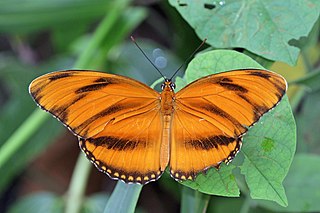
Dryadula is a monotypic genus of the butterfly family Nymphalidae. Its single species, Dryadula phaetusa, known as the banded orange heliconian, banded orange, or orange tiger, is native from Brazil to central Mexico, and in summer can be found rarely as far north as central Florida. Its wingspan ranges from 86 to 89 mm, and it is colored a bright orange with thick black stripes in males and a duller orange with fuzzier black stripes in females.

Battus philenor, the pipevine swallowtail or blue swallowtail, is a swallowtail butterfly found in North America and Central America. This butterfly is black with iridescent-blue hindwings. They are found in many different habitats, but are most commonly found in forests. Caterpillars are often black or red, and feed on compatible plants of the genus Aristolochia. They are known for sequestering acids from the plants they feed on in order to defend themselves from predators by being poisonous when consumed. The adults feed on the nectar of a variety of flowers. Some species of Aristolochia are toxic to the larvae, typically tropical varieties. While enthusiasts have led citizen efforts to conserve pipevine swallowtails in their neighborhoods on the West coast, the butterfly has not been the subject of a formal program in conservation or protected in legislation. The butterfly is however of "Special Concern" in Michigan, which is on the Northern limit of its range.

The black-eared mouse, or black-eared deer mouse, is a species of rodent in the family Cricetidae, native to North America.

Oenomaus is a genus of butterflies in the family Lycaenidae. The species of this genus are found in the Neotropical realm.
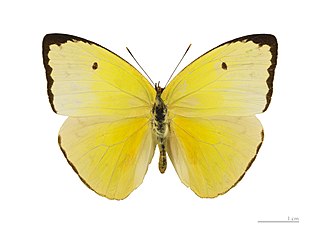
Aphrissa statira, the statira sulphur, is a species of Lepidoptera in the family Pieridae. The species is a medium-sized yellow butterfly, with females more pale than males. They are found from southern regions of Florida and Texas through southern Brazil and northern Argentina. The caterpillars feed on the leaves of several local host plants, while adults prefer to feed on the nectar of red or orange colored flowers. The species is most noted for their dramatic migrations in the tropical areas of the Americas. They have been the subject of many studies about how butterflies navigate and orient during migration.
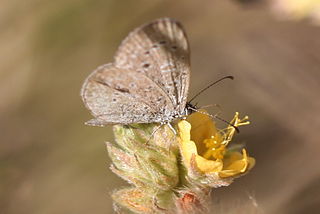
Zizula cyna, the cyna blue, is a butterfly species in the family Lycaenidae.

Catonephele numilia, the blue-frosted banner, blue-frosted Catone, Grecian shoemaker or stoplight Catone, is a butterfly of the family Nymphalidae found in Central and South America.
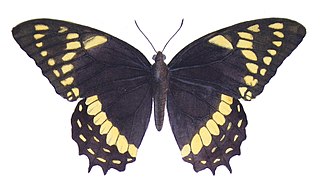
Papilio menatius is a butterfly of the family Papilionidae.
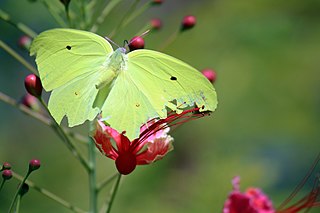
Anteos maerula, the angled sulphur or yellow angled-sulphur, is a butterfly of the family Pieridae. It is found from Peru to Mexico. Rarely, migrants can be found up to eastern Nebraska, south-eastern Arizona, south-western New Mexico, southern Texas, Mississippi and Florida.
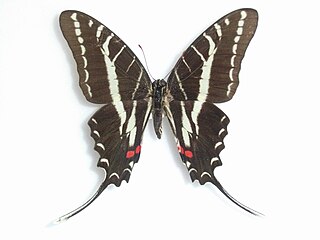
Protographium philolaus, the dark zebra swallowtail or dark kite-swallowtail, is a butterfly of the family Papilionidae. It is found from southern Texas to northern South America.

Catasticta nimbice, the pine white or Mexican dartwhite, is a butterfly in the family Pieridae. It is found from Costa Rica north to Mexico. Rare strays can be found as far north as the Chisos Mountains of western Texas.

Eurema boisduvaliana, commonly known as Boisduval's yellow, is a butterfly in the family Pieridae. It is found from Costa Rica north to Mexico. Rare strays may be found in southern Florida, but it is a regular migrant to south-eastern Arizona, south-western New Mexico, and southern Texas. The habitat consists of subtropical forests and forest edges, scrubs, roadsides and pastures.
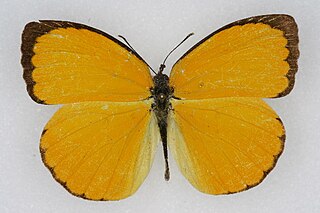
Eurema dina, the dina yellow, is a butterfly in the family Pieridae. The species was first described by Felipe Poey in 1832. It is found from Panama north to southern Florida. The species is regularly recorded from southern Texas and south-eastern Arizona. The habitat consists of forest edges, brushy fields and open forest.

Ganyra josephina, the giant white, is a butterfly in the family Pieridae. It is found from southern Texas through Mexico and Central America to northern South America. The habitat consists of open, dry, subtropical forests.
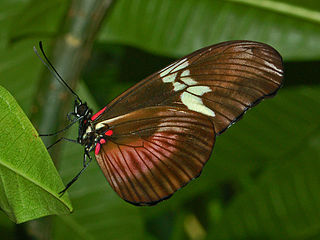
Heliconius hortense, the Mexican longwing, Mexican heliconian or mountain longwing, is a heliconiid butterfly.
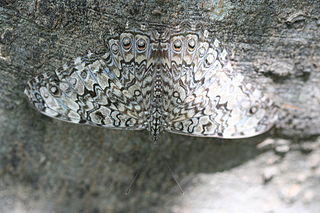
Hamadryas februa, the graycracker, is a species of cracker butterfly in the family Nymphalidae. It is found from Argentina north through tropical America to Mexico. Rare strays can be found up to the lower Rio Grande Valley in southern Texas. The habitat consists of subtropical forests, forest edges and cultivated areas with trees.
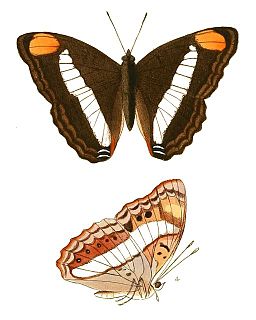
Doxocopa pavon, the Pavon emperor or Pavon, is a species of butterfly in the family Nymphalidae. They can be found from Paraguay in South America up to Texas in the southern United States. They are generally brown in their overall coloration, with two bands of white straddling the middle of the upper surfaces of the wings, and a patch of orange on the tips of their forewings. The upper surfaces of the wings of the males are overlaid by an iridescent blue-purple sheen. The females of the species closely resemble members of the unrelated genus Adelpha.
Oenomaus atesa is a species of butterfly of the family Lycaenidae. It is a widespread species that has been recorded from Mexico, Panama, western Ecuador, French Guiana, Venezuela, Colombia, eastern Ecuador, Peru and Brazil.

Smyrna blomfildia, the Blomfild's beauty, is a species of butterfly in the family Nymphalidae.

Hamadryas iphthime, the ringless blue cracker or brownish cracker, is a species of cracker butterfly in the family Nymphalidae. It was first described by Henry Walter Bates in 1864. It is found in Mexico, Central America and parts of northern South America.

















